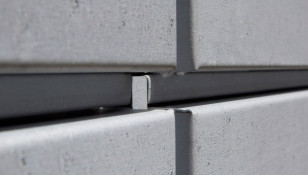VMZ Standing Seam is a ventilated cladding system that can be used for both renovation and new build. As the name standing seam implies, the system consists of seams that can be crimped in a single or double lock (for greater flatness single lock seams sometimes referred to as angle seams are recommended). The system has a traditional look with the seams being 25mm high. The trays can be installed horizontally, vertically and at an angle.
This facade system offers the possibility to clad all types of walls: flat, curved or complex forms. Another great advantage of this zinc facade system is that it can be used on both walls and roofs, thus allowing roof and wall to blend as one (standing seam roofs require double lock seams). The cladding panels can be various sizes but we would not recommend that they be more than 4m in length and 430mm in width. Single lock panels should not exceed 430mm in width. All aspects of VMZINC can be used with 0.8mm being the recommended thickness for facades.
Structure
The system is very lightweight as the panels weigh no more than 7 kg/m2 and can be fixed back to both soft wood open gap boarding and plywood. Both substrates require the use of 18mm thick wood and a vented airspace should be left behind the timber of at least 38mm. The plywood must be weather and boil proof. WBP plywood is more precisely described as EN314-2 (bond class 2) and EN636-2 (timber performance). When soft wood open gap boarding is used it is possible to omit every other board, however a fully boarded substrate should be used in accessible areas. The substrate must be flush to within 2mm and all screws and nails must be countersunk. VMZINC PLUS must be used on plywood substrates, however for vertical surfaces VMZINC and VMZ Membrane can be used on vented plywood. For projects where combustible materials such as plywood cannot be used galvanised steel decks can be used as a substrate – see page 6 for further information.
Installation
The panels are installed in a sequential order from either left to right or right to left for vertical panels. Horizontal panels must be installed from bottom up. For panels less than 2m in length fixed clips can be used. For longer panels sliding clips must be used towards the bottom on vertical panels and to the left and right of the centre for horizontal panels. When using single lock all clips can be fixed. VMZINC clips are made from 304 stainless steel and each clip must resist a pull-out force of 50 daN. It is recommended that screws be used to secure the clips with three being used per sliding clip. The use of nails offers significantly less resistance, but in the event of using nails, contractors are advised to use ring shank nails.
The panels should be installed with the protective film in place.
__West_Sussex_(UK)__(12).jpg)

.jpg)


.jpg)
.jpg)
__Manchester_(UK)_(10).jpg)


_(40).jpg)
